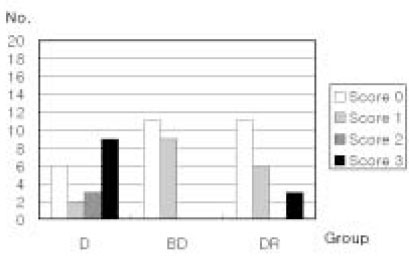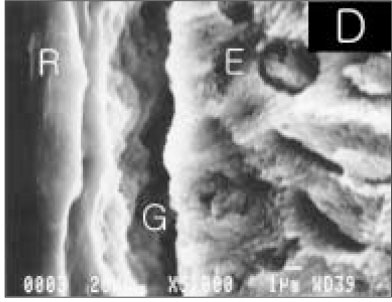J Korean Acad Conserv Dent.
2004 May;29(3):205-211. 10.5395/JKACD.2004.29.3.205.
Effect of wetness on the enamel bonding
- Affiliations
-
- 1Department of Conservative Dentistry, College of Dentistry, Chosun University, Korea. ygcho@mail.chosun.ac.kr
- KMID: 1987095
- DOI: http://doi.org/10.5395/JKACD.2004.29.3.205
Abstract
- This study evaluated the microleakage and interfacial gap between enamel and composite resin under the dry and wet condition of the enamel surface. V shaped class 5 cavities were prepared on the occlusal portion of extracted human molars. Samples were divided into three groups: D group (air dry for 10-15 s), BD group (blot dry with moist cotton pellet), and DR group (air dry for 10-15 s and rewet with Aqua-Prep F for 20 s). Cavities were filled using Aelitefil composite resin after applied One-Step. Microleakage was tested by 2% methylene blue dye solution and the data were statistically analysed by Kruskal-Wallis test and Mann-Whitney test. Also Enamel-resin interface was observed under SEM. Group BD showed statistically lower microleakage than group D (p < 0.05), but there was no statistically significant difference between group BD and DR (p > 0.05). At the enamel-resin interface, group D showed the gap of 2 microm thickness, but group BD and DR showed close adaptation. In conclusion, the use of blot dry and rewetting agent (Aqua-Prep F) resulted in decreased microleakage and improved adhesion between enamel and resin when using One-Step.
Keyword
Figure
Cited by 1 articles
-
Effect of an intermediate bonding resin and flowable resin on the compatibility of two-step total etching adhesives with a self-curing composite resin
Sook-Kyung Choi, Ji-Wan Yum, Hyeon-Cheol Kim, Bock Hur, Jeong-Kil Park
J Korean Acad Conserv Dent. 2009;34(5):397-405. doi: 10.5395/JKACD.2009.34.5.397.
Reference
-
1. Amaral CM, Hara AT, Pimenta LAF, Rodrigues AL Jr. Microleakage of hydrophilic systems in class V composite restorations. Am J Dent. 2001. 14(1):31–34.2. Gladys S, Van Meerbeek B, Lambrechets P, Vanherle G. Microleakage of adhesive restorative materials. Am J Dent. 2001. 14(3):170–176.3. Fanchi M, Breschi L. Effects of acid-etching solutions on human enamel and dentin. Quintessence Int. 1995. 26:431–435.4. Kanca J. Resin bonding to wet substrate. I. Bonding to dentin. Quintessence Int. 1992. 23(1):39–41.5. Moll K, Gartner T, Haller B. Effect of moist bonding on composite/enamel bond strength. Am J Dent. 2002. 15(2):85–70.6. Perdigão J, Frankenberger R. Effect of solvent and rewetting time on dentin adhesion. Quintessence Int. 2001. 32:385–390.7. Swift EJ. Enamel and dentin bonding. J Esthet Dent. 2000. 12(3):119–201.8. Van Meerbeek B, De Munck J, Yoshida Y, Inoue S, Vargas M, Vijay P, Van Landuyt K, Lambrechts P, Vanherle G. Adhesion to enamel and dentin: Current status and future challenges. Oper Dent. 2003. 28(3):215–235.9. Pashley DH, Ciucci B, Sano H, Horner JA. Permeability of dentin to adhesive agents. Quintessence Int. 1993. 24:618–631.10. Gwinnett AJ. Dentin bond strength after air drying and rewetting. Am J Dent. 1994. 7(3):144–148.11. Tay FR, Gwinnett JA, Wei SHY. Micromorphological spectrum of acid conditioned dentin following the application of a water-based adhesive. Dent Mater. 1998. 14:329–338.
Article12. Nakajima M, Kanemura N, Pereira PNR, Tagami J, Pashley DH. Comparative microtensile bond strength and SEM analysis of bonding to wet and dry dentin. Am J Dent. 2000. 13(6):324–328.13. Gallo JR, Henderson M, Burgess JO. Shear bond strength to moist and dry dentin of four dentin bonding systems. Am J Dent. 2000. 13(5):267–270.14. Pashley DH, Carvalho RM, Tay FR, Agee KA, Lee KW. Solvation of dried dentin matrix by water and other polar solvents. Am J Dent. 2002. 15:97–102.15. Braga RR, Cesar PF, Gonzaga CC. Tensile bond strength of filled and unfilled adhesives to dentin. Am J Dent. 2000. 13(2):73–76.16. Gwinnett AJ. Moist vs. dry dentin: Its effect on shear bond strength. Am J Dent. 1992. 5:127–129.17. Kanca J 3rd. Effect of resin primer solvents and surface wetness on resin composite bond strength to dentin. Am J Dent. 1992. 5:213–215.18. Ritter AV, Heymann HO, Swift EJ, Perdigao J, Rosa BT. Effects of different re-wetting techniques on dentin shear bond strengths. J Esthet Dent. 2000. 12(2):85–96.
Article19. Perdigão J, Van Meerbeek B, Lopes MM, Ambrose WW. The effect of a re-wetting agent on dentin bonding. Dent Mater. 1999. 15:282–295.
Article20. Pilo R, Cardash HS, Oz-Ari B, Ben-Amar A. Effect of preliminary treatment of the dentin surface on the shear bond strength of resin composite to dentin. Oper Dent. 2001. 26:569–575.21. Kanca J. Resin bonding to wet substrate. II. Bonding to enamel. Quintessence Int. 1992. 23(9):625–627.22. Jain P, Stewart GP. Effect of dentin primer on shear bond strength of composite resin to moist and dry enamel. Oper Dent. 2000. 25:51–56.23. Gordan VV, Vargas MA, Denehy GE. Interfacial ultrastructure of the enamel/dentin bonding agents. Am J Dent. 1998. 11:13–16.24. Buonocore MG. Simple method of increasing the adhesion of acrylic filling materials to enamel surfaces. J Dent Res. 1955. 28:849–853.25. Abdalla AI, Garcia-Godoy F. Morphological characterization of single bottle adhesives and vital dentin interface. Am J Dent. 2002. 15(1):31–34.26. Baratieri LN, Canabarro S, Lopes GC, Ritter AV. Effecct of resin viscosity and enamel beveling on the clinical performance of class V composite restorations: Three-year Results. Oper Dent. 2003. 28(5):482–487.27. Barghi N, Knight GT, Berry TG. Comparing two methods of moisture control in bonding to enamel: A clinical study. Oper Dent. 1991. 16:130–135.28. Knight GT, Berry TG, Barghi N, Burns TR. Effects of two methods of moisture control on marginal microleakage between resin composite and etched enamel: a clinical study. Int J Prosthodont. 1993. 6(5):475–479.29. Perdigão J, Swift EJ, Heymann HO, Malek MA. Effect of a re-wetting agent on the performance of acetone-based dentin adhesives. Am J Dent. 1998. 11:207–213.30. Tay FR, Gwinnett AJ, Wei SHY. Ultrastructure of the resin-dentin interface following reversible and irreversible rewetting. Am J Dent. 1997. 10(2):77–82.31. Swift EJ. Resin desensitizers. J Esthet Dent. 1999. 11(6):289–290.
- Full Text Links
- Actions
-
Cited
- CITED
-
- Close
- Share
- Similar articles
-
- Comparison of shear bond strength of different bonding systems on bleached enamel
- The effect of repeated bonding on the shear bond strength of different resin cements to enamel and dentin
- The increase of enamel crack in debonding teeth
- Bond strength according to the adhesive type and the distance between enamel surface and resin base in indirect bonding
- Evaluation of different enamel conditioning techniques for orthodontic bonding





